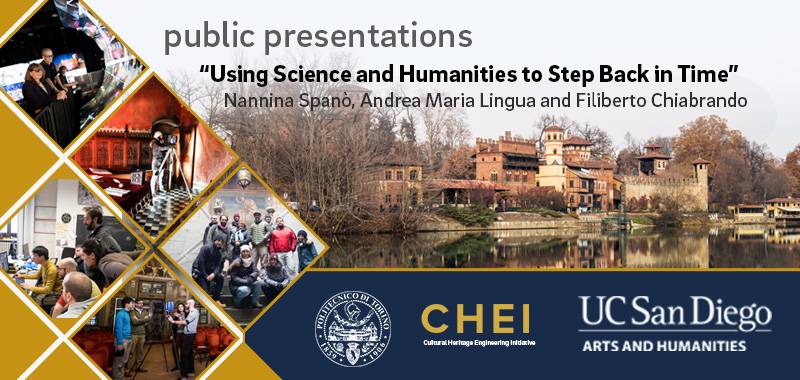Jun 3, 2019–Jun 3, 2019 from 4:00pm–5:30pm
Using Science and Humanities to Step Back in Time

public presentations
“Using Science and Humanities to Step Back in Time”
Monday June 3 from 4:00 to 5:30 pm
UC San Diego Atkinson Hall—Calit2 Theater Vroom
Join Cristina Della Coletta, the Dean of the Division of Arts & Humanities and the Cultural Heritage Engineering Initiative at UC San Diego for public presentations by Professor Nannina Spanò, Professor Andrea Maria Lingua and Professor Filiberto Chiabrando from the Polytechnic University of Turin (Italy).Professor Filiberto Chiabrando Talk: TURIN 1911 PROJECT: ON GOING ACTIVITIES AND FURTHER DEVELOPMENT Filiberto Chiabrando is an associate professor in Geomatics at the Polytechnic University of Turin (Italy) Department of Architecture and Design (DAD) and adjunct assistant professor at the School of Technology at the Michigan Technological University. The lecture of Filiberto Chiabrando focuses on the ongoing project, Turin 1911,—a cooperation between the Politecnico di Torino and the University of California San Diego. The aim of the project, connected to the “Fabulous Exposition” that took place in 1911 in the Valentino Park, is the realization of a multi-scale reconstruction of the no longer existing structures in the park. Covering more than 400,000 m2, the project will provide a virtual and immersive visualization of the Turin 1911 international exposition. Professor Chiabrando will present the different research methods and systems employed on the field. Relevant results will be shared in order to show the potential of the multidisciplinary approach for the documentation of complex Cultural Heritage sites. Professor Nannina Spanò Talk: RESEARCH AND ACTIVITIES OF THE DEPARTMENT OF ARCHITECTURE AND DESIGN (DAD) AND THE LABORATORY OF GEOMATICS FOR CULTURAL HERITAGE Nannina (Antonia) Spanò is an associate professor in the discipline 08-Civil engineering and architecture / 04: Geomatica, from 2014, at Polytechnic University of Turin (Italy) - Department of Architecture and Design (DAD). The lecture held by Nannina Spanò focuses on the activities of the Geomatics for Cultural Heritage Lab of the Politecnico of Turin. The goal is to highlight cooperation activities among the Department of Architecture and Design and relative PhD programs and national and international collaborators. Professor Spanò shows how the Geomatics methods and systems are currently part of many human activities, having taken on important roles in the research initiatives of many neighboring fields of study. In particular, Geomatics methods have become a relevant support for the analysis and 3D modeling and representation of living environments, cities, and built spaces and artistic expressions in a broad sense. Professor Andrea Maria Lingua Talk: RESEARCH AND ACTIVITIES OF THE DEPARTMENT OF ENVIRONMENT, LAND AND INFRASTRUCTURE ENGINEERING (DIATI) AND THE POLITO-INTERDEPARTMENTAL CENTRE FOR SERVICE ROBOTICS (PIC4SER) Andrea Maria Lingua is a professor in Geomatics, at the Department of Environment, Land and Infrastructure Engineering (DIATI) at the Politecnico di Torino. The lecture of Andrea Maria Lingua documents the activities of the laboratory of Photogrammetry, Geomatics and GIS of the Department of Environment, Land and Infrastructure Engineering. These activities include: (a) research (innovation in the whole geomatics process from acquisition techniques/methods to 3D geodatabase including fast and real time processing); (b) teaching (PhD program in Urban and Regional Development, master of science programs, innovative didactic projects), and (c) public engagement (technology transfer and scientific disclosure for society). The laboratory was recently included in the POLITO Interdepartmental Center for Service Robotics (PIC4SeR), where tools and skills are shared to organically synthesize the characteristics of different application scenarios (precision agriculture, smart cities, search&rescue, patrolling and early warning systems, etc.) and their related robotic experimental solutions. The technological expertise of PIC4SeR involves mechatronic technology on service robots, maritime and aerial applications; multi sensors data acquisition, synchronization, fusion and integration using navigation sensors (GNSS, IMU), imaging sensors (high resolution digital camera in visible, infrared, thermal, multispectral, hyperspectral fields), terrestrial/aerial laser scanner, real time processing and transmission of stereoscopic RGB data and 3D models for virtual/augmented reality; human interaction and multimedia interfaces.
About Turin 1911:
Turin 1911: The World’s Fair in Italy is the first digital project devoted to the only universal exposition ever held in Italy Led by Dean Cristina Della Coletta. Though World’s fairs were among the West’s largest mass-attended events, they were also ephemeral occurrences designed to exhibit, rather than preserve, the changing world of modernity. Turin 1911 was no exception. Once the Fair was dismantled, its artifacts were scattered among institutional archives and private collectors, thus failing to be studied in a systematic manner. The project has evolved to include a partnership among the UC San Diego Division of Arts & Humanities, the Cultural Heritage Engineering Initiative (CHEI) at the UC San Diego Jacobs School of Engineering (JSOE), and the Politecnico di Torino, Italy (POLITO).About CHEI:
The Cultural Heritage Engineering Initiative at UC San Diego brings the power of student-driven engineering to the study and preservation of monuments, historic structures, archaeological sites, art and other artifacts. CHEI has created a comprehensive methodology and toolbox – integrating instru-ments for data collection, processing, analysis, visualization, and dissemination, with expertise in field deployment, training, and outreach. http://chei.ucsd.eduDate and Time
Jun 3, 2019–Jun 3, 2019
from 4:00pm–5:30pm
Location
Event Registration
Registration is not required for this event.
Event Fee
FREE
Contact
Dominique Rissolo • drissolo@ucsd.edu
Audience
Faculty, Staff, Students, The General Public
Event Host
The Division of Arts & Humanities and the Cultural Heritage Engineering Initiative